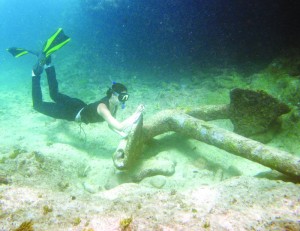
This week we continue our journey intoAnguilla’s maritime heritage, travelling back to 1772, when sugar plantations dotted the landscape and the population hovered between two and three thousand people. That year, one ofSpain’s last flotas leftCadiz,Spain. The ancient convoy system which had been in place since the early 1500s was designed to guard against pirates and protect the treasure fleets when they returned from theNew World.
As sometimes happened, two ships became separated from the group sailing together in good spirits until, on a calm night at 1:30 in the morning, the 980-ton Nau El Buen Consejo ran aground off the coast of Anguilla (the vessel travelling with her also ran aground and was lost). Miraculously, no one was injured. The ship was carrying a mixed cargo of trade goods and passengers bound forMexico. Among the passengers were 52 Franciscan missionaries carrying a consignment of religious medallions and the materials they would need to establish a new mission in theNew World. Despite over a month of attempted salvage, many artefacts including the bronze medallionsand the ship’s artillery could not be recovered.

The crystal waters of theCaribbeanhave long been a stomping ground for avocational and professional treasure hunters. Unfortunately, their activities result in a permanent loss of information and history. In 1987, Anguillian fisherman ‘Bull’ Bryan relocated what was left of the large wreck. Washed by the sea on an exposed part of coast, the ship’s timbers had long disappeared but pieces of cargo and cannons could still be seen, encrusted in coral on the sea floor. He proceeded to show the site to a number of tourists and soon treasure hunters became interested.
In 1994, the vessel now identified as El Buen Consejo (translated “Good Counsel”) became the centre of controversy when several treasure hunters sought permits to salvage the site. The site was protected by the Government of Anguilla as an Underwater Archaeological Preserve in 1995. Unfortunately, looters removed many artefacts including coins, buttons and medallions. One such collection was recovered and returned toAnguillaby the FBI in 2009. Its recovery will hopefully serve as a warning for others who would stealAnguilla’s heritage.
While this leavesAnguillawith one of the largest collections of these medallions in the world, much more has been lost. Artefacts taken from the sea are especially fragile. Years under the sea change their chemistry and unless they are conserved as soon as they are removed from water they will quickly disintegrate.
Today, the site consists of 29 cannon and three anchors. It is located in a high energy environment. Unfortunately, plans to develop a marine park and museum have failed to materialize and it is not possible to visit the site today. If you would like more information about the wreck, please contact the Anguilla Archaeological and Historical Society or send an email to maritimearcheology@gmail.com.








